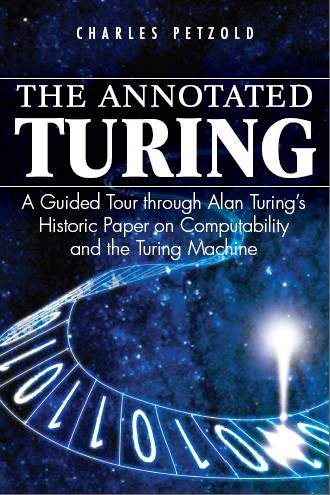The Annotated Turing

Chapter 2 - The Irrational and the Trascendental
There's one thing in chapter 2 (page 31) I find hardly convincing.
Petzold is talking about the Continuum Hypothesis, formulated (but not proven) by Cantor.
\[ \aleph_1 = 2^{\aleph_0} \]
Before that, he shows that $ \lvert \mathbb{R} \rvert = 2ℵ0$.
The general rule is that:
\[ \textrm{cardinality of a power set} = 2^{\textrm{cardinality of the original set}} \]
Here what happens if we construct the power set of the natural numbers.
We must find some order in our operations. The infinite sequence of natural numbers is set as a header. Then, for each row, we put 0s or 1s depending on whether the corresponding number is in the current element of the power set.
| 0 | 1 | 2 | 3 | 4 | 5 | … | Subset |
|---|---|---|---|---|---|---|---|
| 0 | 0 | 0 | 0 | 0 | 0 | … | \(\{\}\) |
| 1 | 0 | 0 | 0 | 0 | 0 | … | \(\{0\}\) |
| 0 | 1 | 0 | 0 | 0 | 0 | … | \(\{1\}\) |
| 1 | 1 | 0 | 0 | 0 | 0 | … | \(\{0,1\}\) |
| 0 | 0 | 1 | 0 | 0 | 0 | … | \(\{2\}\) |
And so on. Proceeding like that we construct every possible infinite sequence of 0s and 1s, each one corresponding to one element of the powerset of \( \mathbb{N} \).
If these sequences of symbols are interpreted as binary encodings of real numbers (like \( 100000… \rightarrow .100000… \)), then they are all the real numbers between 0 and 1.
Since this set can be put in correspondence with the entire set of real numbers, it follows that the cardinality of \( \mathbb{R} \) and the cardinality of the powerset of \( \mathbb{N} \) are the same.
In a footnote, Petzold says that one must not believe that we found a way to enumerate all reals (which is indeed impossible), because there are no transcendental numbers in the set. That is true, Petzold says, because "each number has a finite number of 1s after the period".
I'm sure that is true, but didn't we just say that we listed all real numbers? Isn't "all real numbers between 0 and 1 except for the transcendental numbers" a different set?
This is what I find not very convincing.
- Update
I posted a slightly modified version of this text as a question on math.stackexchange.